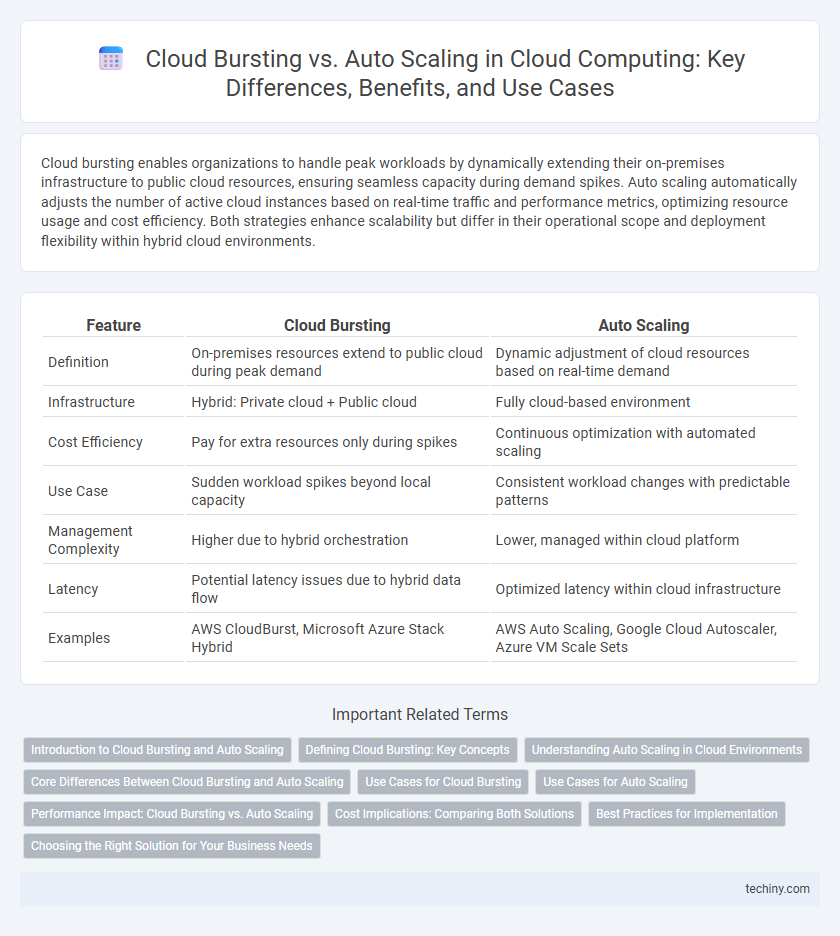Cloud bursting enables organizations to handle peak workloads by dynamically extending their on-premises infrastructure to public cloud resources, ensuring seamless capacity during demand spikes. Auto scaling automatically adjusts the number of active cloud instances based on real-time traffic and performance metrics, optimizing resource usage and cost efficiency. Both strategies enhance scalability but differ in their operational scope and deployment flexibility within hybrid cloud environments.
Table of Comparison
| Feature | Cloud Bursting | Auto Scaling |
|---|---|---|
| Definition | On-premises resources extend to public cloud during peak demand | Dynamic adjustment of cloud resources based on real-time demand |
| Infrastructure | Hybrid: Private cloud + Public cloud | Fully cloud-based environment |
| Cost Efficiency | Pay for extra resources only during spikes | Continuous optimization with automated scaling |
| Use Case | Sudden workload spikes beyond local capacity | Consistent workload changes with predictable patterns |
| Management Complexity | Higher due to hybrid orchestration | Lower, managed within cloud platform |
| Latency | Potential latency issues due to hybrid data flow | Optimized latency within cloud infrastructure |
| Examples | AWS CloudBurst, Microsoft Azure Stack Hybrid | AWS Auto Scaling, Google Cloud Autoscaler, Azure VM Scale Sets |
Introduction to Cloud Bursting and Auto Scaling
Cloud Bursting enables on-premises applications to offload peak workloads to a public cloud, ensuring seamless resource expansion during demand surges without permanent infrastructure investment. Auto Scaling automatically adjusts the number of active cloud instances based on real-time metrics such as CPU usage and network traffic, optimizing performance and cost efficiency. Both technologies enhance cloud resource management but differ in deployment scope and scaling triggers, with Cloud Bursting bridging private and public clouds, while Auto Scaling operates within a single cloud environment.
Defining Cloud Bursting: Key Concepts
Cloud bursting enables on-premises applications to dynamically extend into a public cloud during peak demand, ensuring seamless resource availability. This hybrid cloud strategy helps maintain performance without overprovisioning local infrastructure. Key components include workload monitoring, seamless data transfer, and burst-triggering policies to optimize operational costs and scalability.
Understanding Auto Scaling in Cloud Environments
Auto scaling in cloud environments dynamically adjusts computing resources based on real-time demand, ensuring optimal performance and cost efficiency. By continuously monitoring metrics such as CPU usage and network traffic, auto scaling automatically adds or removes instances to maintain application stability. This approach minimizes manual intervention and supports seamless handling of variable workloads compared to cloud bursting, which temporarily extends capacity to external clouds.
Core Differences Between Cloud Bursting and Auto Scaling
Cloud bursting enables applications to seamlessly extend workloads from private clouds to public clouds during peak demand, providing temporary resource expansion without permanent infrastructure changes. Auto scaling automatically adjusts the number of active servers or instances within a cloud environment based on real-time performance metrics, optimizing resource utilization and cost efficiency. Core differences include cloud bursting's reliance on hybrid cloud architecture versus auto scaling's native cloud service functionality, and the conditional use of external resources in cloud bursting compared to auto scaling's automatic vertical or horizontal scaling within a single cloud provider.
Use Cases for Cloud Bursting
Cloud bursting is ideal for applications with unpredictable or seasonal spikes in demand, allowing businesses to handle peak workloads by dynamically allocating additional resources from a public cloud while maintaining baseline capacity in a private cloud. This approach is particularly effective for industries such as retail during holiday sales, financial services during market volatility, and media streaming during major live events. Cloud bursting ensures cost efficiency by avoiding permanent overprovisioning and enhances performance by seamlessly extending on-premises infrastructure when needed.
Use Cases for Auto Scaling
Auto scaling is ideal for cloud environments with fluctuating workloads, ensuring optimal resource utilization by automatically adjusting compute capacity based on real-time demand. It is commonly used in e-commerce platforms, web applications, and microservices architectures where traffic patterns vary unpredictably. By maintaining performance during traffic spikes and reducing costs during low-usage periods, auto scaling supports highly dynamic and scalable cloud infrastructures.
Performance Impact: Cloud Bursting vs. Auto Scaling
Cloud Bursting leverages a hybrid cloud environment to handle sudden spikes in workload by offloading excess demand to a public cloud, which can introduce latency and potential consistency challenges due to data synchronization between private and public clouds. Auto Scaling dynamically adjusts resources within a single cloud environment based on real-time demand, providing more seamless performance improvements with minimal latency. While Cloud Bursting is beneficial for cost containment during peak usage, Auto Scaling offers more efficient performance optimization through rapid resource provisioning and scaling within the primary cloud infrastructure.
Cost Implications: Comparing Both Solutions
Cloud bursting enables businesses to handle peak workloads by temporarily extending to public clouds, often resulting in higher costs due to data transfer and on-demand resource pricing. Auto scaling adjusts resources dynamically within the same cloud environment, optimizing costs by matching capacity directly to demand and reducing unused capacity expenses. Evaluating cost implications involves analyzing workload patterns, as cloud bursting incurs variable additional charges while auto scaling promotes cost efficiency through automated resource management.
Best Practices for Implementation
Cloud bursting and auto scaling optimize resource management in cloud computing by balancing workload flexibility with cost efficiency. Best practices for cloud bursting include configuring seamless integration between private and public clouds to prevent latency and security issues, while ensuring robust monitoring and automated failover mechanisms. For auto scaling, implement precise threshold metrics and predictive analytics to dynamically adjust resources, thereby minimizing downtime and optimizing performance during traffic spikes.
Choosing the Right Solution for Your Business Needs
Cloud bursting enables businesses to handle traffic spikes by offloading excess workloads to public clouds, optimizing cost and resource use during peak demand. Auto scaling automatically adjusts server capacity based on real-time traffic patterns, ensuring consistent performance and minimizing downtime without manual intervention. Selecting the right solution depends on workload predictability, budget constraints, and the degree of control required over cloud resources to balance efficiency and scalability.
Cloud Bursting vs Auto Scaling Infographic

 techiny.com
techiny.com